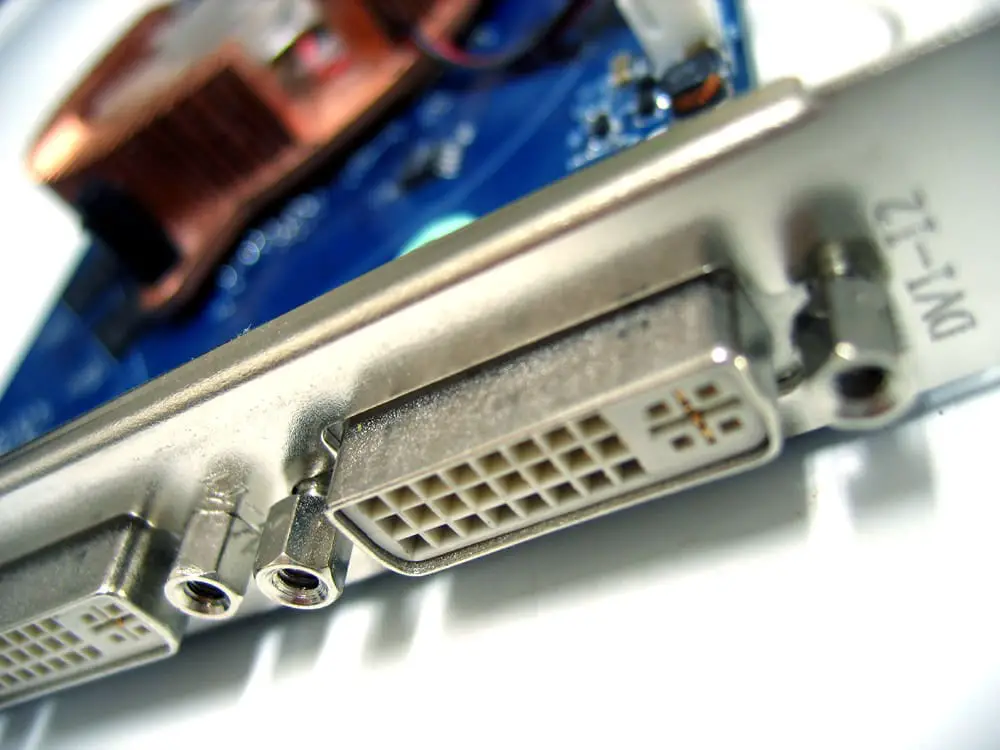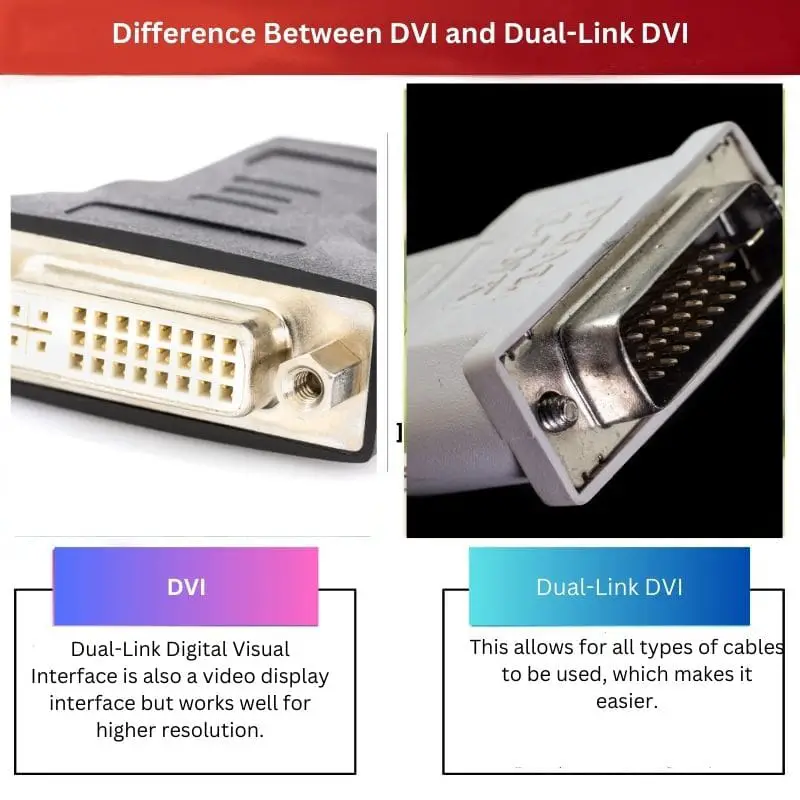Connecting a VGA analogue monitor to a computer is an ancient practice and has been considered a standard method. Since then, many new approaches and traditional methods have been proposed.
Thus, later on, new interfaces were created for video cards, which came to be known as DVI. Single and dual DVI. In the below sub-sections, we would see differences between.
Key Takeaways
- Digital Visual Interface (DVI) is a video display interface that transmits digital video signals, while Dual-Link DVI increases the bandwidth, allowing for higher resolutions and refresh rates.
- Standard DVI supports resolutions up to 1920×1200, while Dual-Link DVI can handle resolutions up to 2560×1600.
- Dual-Link DVI cables have more pins than single-link DVI cables, enabling the transmission of more data between devices.
DVI vs Dual-Link DVI
DVI (Digital Video Interface) is a standard for transferring digital video data from a computer to a display device such as a monitor or projector. It provides a high-quality digital video signal. Dual-Link DVI is an enhanced version of DVI that supports higher resolutions and bandwidth by using additional data channels. It is used for high-end displays.

Digital Visual Interface was developed by the Digital Display Working Group, and its first display interface for videos with a 60Hz refresh rate.
It is used in many ways, such as for video display, where it acts as a controller, to connect to display devices, monitors, etc. The primary purpose of creating this was to transfer video content.
Doubling the data pairs is done by Dual-Link DVI, as its name suggests. It supports pixel clock resolution up to 330 Hz. Dual-link DVI supports up to 2560*1600 at 60 Hz resolution.
Initially, it’s wa designed for uncompressed digital videos. This interface is primarily intended for uncompressedThis allows for all types of cables to be used,, making it more accessible.
Comparison Table
| Parameters of comparison | DVI | Dual-Link DVI |
|---|---|---|
| Definition | Dual-Link Digital Visual Interface is also a video display interface but works well for higher resolution. | This allows for all types of cables to be used, which makes it easier. |
| Resolutions | DVI supports only 1920*1200 at 60 Hz resolution | Dual-link DVI supports up to 2560*1600 at 60 Hz resolution. |
| Number of Pins | It uses 12 pins only. | It uses all 24 pins. |
| Cables | This allows certain types of cables only. | The primary purpose of creating this was to transfer video content. |
| Uses | It’s designed for uncompressed video. | It’s designed for uncompressed video |
What is DVI?
This type of interface is primarily designed for the transmission of video. It supports different variations of the DVI like DVI-A (analogue only), DVI-D (Digital only), or DVI-I (Digital and Analog), etc.
DVI is mainly connected to the computer, but sometimes it is added to other electronic devices, in which the consumer’s convenience remains, such as TV, DVD player, etc.
The format of DVI is mainly associated with panel links. Silicon Image created the design for the DVI Single link.
It uses a high-speed serial link called TMDS, and DVI also includes the option to display data channels, which are also available in analogue VGA connectors.
There is no specified length for DVI cables. It depends on the pixel clock frequency. If we talk about its size, its approximate size is considered to be 4.5 meters which is limited for display resolution up to 1920×1200.
They are also limited to display resolution up to 1280×1024 if the cable length is 15 meters. DVI boosters are used to maintain the balance of the existing signal.
DVI links generate the difference between the data and the clock. DVI is used to balance the variation between the specification input clock.
For example, DVI allows input clock variation between 25 and 165 MHz. This ratio keeps on increasing and decreasing.

What is Dual-Link DVI?
Dual-link connectors support all types of data rates, which makes them stand out. As reflected by its name, it doubles the number of data pairs.
Supports effective pixel clock resolutions up to 330 Hz. It supports the highest resolution, up to 60 Hz. This interface is primarily designed for uncompressed digital video only.
If we talk about the function of the dual-link DVI, it covers the doubling power of transmission, and provides good speed and adequate signal quality.
The number of pins available in dual-link connectors is 24, which is more than a single-link connector. The bandwidth is also increased in dual-link DVI.
It provides higher resolution with large distances without any interference. The cables of dual-link DVI are made up of copper, which overcomes several challenges.
It supports data up to 3.30Gbps. The copper wires of cables provide minimal insertion loss. It is lightweight and flexible by nature. The connectors are gold-plated.
It is covered with a triple shield and noise resistant, i.e. superior noise immunity. It is green-friendly, i.e. RoHS compliant. The performance of these cables is excellent.
The lighter weight of the wire increases the flexibility, suitable for short-length interconnection cables.

Main Differences Between DVI and Dual-Link DVI
- Digital Visual Interface cannot support dual-link connectors, whereas Dual-Link DVI is fully backwards compatible with single DVI.
- DVI supports only 1920*1200 at 60 Hz resolution, whereas Dual-link DVI supports up to 2560*1600 at 60 Hz resolution.
- DVI uses only 12 pins out of 24 while Dual-link DVI adds an extra 12 pins, which enables for higher bandwidth, approx 2Gbps
- DVI allows certain types of cables only, while The lines of dual-link DVI are made up of copper, which overcomes several challenges.
- The main purpose of creating this was to transfer video content, whereas dual-link DVI covers the doubling power of transmission and provides good speed and effective signal quality.

- https://computerstationnation.com/difference-between-hdmi-dvi-vga-and-usb-c/
- https://onlinelibrary.wiley.com/doi/abs/10.1889/1.1830222
- https://www.sciencedirect.com/science/article/pii/S1546144014005511

A compelling comparison between traditional and new techniques for video display. Enlightening! It would have been more helpful if you described the implications of each technology in a practical manner.
The article has a well-structured comparison between DVI and Dual-Link DVI. However, it would be beneficial to include practical case studies or scenarios where these interfaces have been used to provide a complete understanding of their utility.
The comprehensive comparison between DVI and Dual-Link DVI is informative. The addition of real-world examples or case studies would enhance the practical insight for the readers. A valuable discussion and valuable insights are presented.
The in-depth explanation provided in the article makes it insightful. A more balanced view of the advantages and disadvantages of each type of interface would be of great value to the readers.
This article provides a detailed comparison between DVI and Dual-Link DVI. An additional section explaining the applications and situations in which one would be preferred over the other would enhance the article further.
The comparison between DVI and Dual-Link DVI is well-explained, but the practical applications were not covered in sufficient depth. Practical applications would make it more comprehensive.